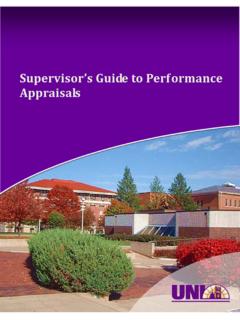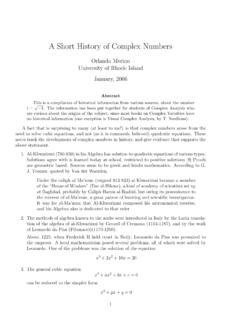Transcription of Presentation: Performance Appraisal Training
1 presentation : Performance Appraisal Training Late Updated: 3/27/2012 Slide 1: Welcome to Part 1 of Performance Appraisal Training . This Training is being provided by Human Resource Services. Slide 2: Learning Objectives The learning objectives for this Training are: Preparing for and conducting Performance appraisals Goal setting Documenting Performance Enhancing coaching skills Creating a Performance Improvement Plan (PIP) By attending this Training , you will learn and grow your Performance management skills. We will focus on the P&S Performance Appraisal process first, but we will also spend some time on each part of the overall Performance management process. Slide 3: Why Appraisals Are Important to Employees Learn areas of strength and weakness Tangible record of how they are doing Know expectations Supports development Encourages accountability Opportunity to discuss career development For employees, this is an opportunity to hear about what they are doing well and what areas need improvement.
2 This can serve as a huge motivating factor for employees. Also, by having a formal Appraisal , they will know and remember what it is they need to improve upon. This also is a chance for expectations to be highlighted. Whether these are expectations that are highlighted in the job description, or they are new expectations based on a recent responsibility that this employee has undertaken, this meeting is the time to lay them all out. Goal setting is a crucial part of the meeting as well. These goals set the stage for the next year, and give the supervisor a framework for holding the employee accountable for accomplishing goals. It is also a great time for employees and their supervisors to talk about career development.
3 Supervisors can offer guidance, support, Training , or job enrichment opportunities to help employees gain new skills and experiences. Slide 4: Why Appraisals Are Important to Supervisors Consistent evaluation Helps identify their own strengths and weaknesses Motivation Accountability Individual goals vs. organizational goals Career development Conducting Performance appraisals is an important process for supervisors as well. Performance appraisals demonstrate to employees how they perform is important and they are accountable for their Performance . If employees across the board are showing deficiencies in one particular area, it gives the supervisor something they can go back and evaluate themselves on, in order to develop action plans for improvement.
4 These meetings can be great motivators for employees, which helps supervisors. No supervisor will ever directly motivate an employee. Motivation comes from within, but helping an employee outline practical goals for the upcoming year will go far in helping them become motivated. In the goal setting process, supervisors can help their employees shape goals to fit with organizational goals. As mentioned previously, this also a good time to speak with employees about career development. Good supervisors know an employee s career development isn t just the employee s responsibility. Employees want to know their supervisor supports their desire for career development opportunities such as leading projects or attending Training that will help them now and in their next career step.
5 Slide 5: Scheduling the Appraisal Meeting 1 week notice Set aside 1 hour Use it as a follow up for a previous Appraisal Encourage the employee to prepare for the meeting -- P&S Self- Appraisal -- Supervisor Appraisal -- Merit Discussion Guide It is important to let your employee know at least one week in advance so they can clear at least an hour in their schedule and do their own preparation for the meeting. It is also important that this time is distraction free. Close the door, set your phone to Send Calls mode, and make sure the employee knows they have your undivided attention. The simple fact you care enough to tell them how they are doing goes a long way and can be a very important part when it comes to the motivation of employees.
6 If this isn t your first Performance Appraisal with this employee, use the previous year s Appraisal as a starting point. Discuss progress toward goals, and make sure you don t rush through any part of this meeting. If you rush, it not only shortchanges your employee but can also make them feel less important. Slide 6: Annual Performance Appraisal Forms Preparation is key Stay on top of it all year Identify expected outcomes and possible solutions The Forms Repository has a list of various forms used at UNI. At the top, click on the letter P. Scroll down to Performance Appraisals. Select the appropriate form, based on the classification of the employee that you are evaluating, either Merit or P&S. It is important to have this form ready to go before the meeting.
7 Staying prepared all year by keeping Performance Appraisal notes, which will be covered more in depth later, can have huge impacts on the success of the meeting. For expected outcomes that have not been achieved, it is important to have possible solutions identified before the meeting, but it is also important for the employee to assist in identifying solutions. Slide 7: Merit Employees Forms & Timeline Differences Performance appraisals are completed annually, 12 months from last review date For Merit employees in probationary status, complete the 3 month and 6 month evaluation, then 12 months from that date Utilize Two-Week Discussion Guide Separate Appraisal forms for AFSCME-covered and Supervisory & Confidential For Merit employees in probationary status, since they are either a new employee or an employee who has recently moved to a new position through a transfer or promotion, a three month and a six month evaluation will need to be completed and turned into HRS.
8 Performance appraisals for permanent merit employees are completed annually, 12 months from their last review date. There is also a two week discussion guide to ensure the employee s Performance starts on the right track. The three month evaluation form should be completed toward the end of the second month or beginning of the third month. On the form, the supervisor would recommend if the new hire employee would continue their probationary period or recommend termination. If evaluating a regular employee in a new position, the three month evaluation would be considered an interim evaluation and a second evaluation (six-month evaluation form) will need to be completed before the end of the probationary period. The six month evaluation form should be completed toward the end of the fifth month or beginning of the sixth month of the probationary period.
9 Do not wait until the end of the six month probationary period to complete the evaluation, especially if there is a chance the recommendation will be termination. Slide 8: Helpful Items for Writing the Appraisal Include the following: Job Description Attendance record Notes on their Performance Current projects they are working on Examples of successes and areas of improvement Work examples from the past year Notes on interaction with coworkers Job or career objectives from last review List of professional development activities completed during past year Recommendations for professional development for the upcoming year Slide 9: Rating Scale The rating categories on the P&S Performance Appraisal form include.
10 Exceptional Highly Successful Satisfactory Needs Development Unacceptable Remember the rating categories on the Merit forms are slightly different but the definitions are consistent. There are many misconceptions about these ratings. Supervisors often think that if an employee is essentially performing the duties listed in their position description, they deserve the rating of Exceptional. An Exceptional rating should only be reserved for those who routinely contribute at a level that is far above the requirements of the position. An Exceptional rating implies this employee is the best at this particular function. A Highly Successful rating suggests an employee goes above and beyond what is expected of them.






